(Spotlight Delaware is a community-powered, collaborative, nonprofit newsroom covering the First State. Learn more at spotlightdelaware.org).
The Sussex County Council will soon consider a potential roadmap for addressing the effects of development in the region.
But what does that roadmap actually say?


The Sussex County Land Reform Working Group, tasked by County Council with recommending development reforms, finalized its 19 draft recommendations on Thursday, Aug. 21.
County Council asked the working group to propose reforms to the county’s development codes to ease the impact ongoing growth has had on affordability, road conditions, services and the environment.
The 19 recommendations attempt to address these concerns and more, but to someone outside the world of land use planning, they can be difficult to understand.
Ahead of the working group’s final meeting regarding the recommendations on Sept. 11, Spotlight Delaware has broken down the proposals’ meaning and potential impacts:
1. Aligning the future land use map
As the county prepares to create its next comprehensive plan in 2028, the land use working group wants to ensure the next land use map reflects the development goals laid out in its recommendations, like encouraging development in some areas and discouraging it in others. The public will be able to comment on the draft plan as it is being created in the next few years.
 A look at Sussex County’s future land use map from its 2018 comprehensive plan. | PHOTO COURTESY OF SUSSEX COUNTY
A look at Sussex County’s future land use map from its 2018 comprehensive plan. | PHOTO COURTESY OF SUSSEX COUNTY2. Establishing growth and conservation areas
Growth areas are locations where the county would allow more construction, and conservation areas are places where the county would work to preserve land as it is.
The working group wants County Council to outline growth areas where there is the right infrastructure – such as sewers, public water, and emergency and main roadways – to support it. All other land, the group suggests, should be designated as conservation areas.
3. Comprehensive rezoning
Zoning is a local law determining how land can be used in certain areas. Rezoning is the process of changing these regulations, which then changes what can be built on a property.
This recommendation proposes rezoning county lands to match up with the growth and conservation areas County Council establishes.
4. Establishing clear standards for rezoning
This recommendation advises county officials to make the rezoning application process consistent for the whole county and “legally defensible,” meaning if there were any lawsuits regarding the process, the county could defend it.
Developers apply to rezone a property when it does not match what they want to build. Jill Hicks, a working group member and president of the Sussex Preservation Coalition, said both she and the developers of the group feel the current process is too subjective.
“Any time we can establish clear standards where the developers and the public know what to expect, I think it’s good,” Hicks said.
5. Defining “missing middle” housing types
“Missing middle housing” is a phrase commonly used to refer to duplexes, triplexes, and other housing types that are smaller than single-family homes, but larger than apartments. These types of housing would be more affordable for middle-class families but are not currently being built as often as apartment complexes or single-family homes in Delaware and across the country.
The working group suggests county officials add definitions for four missing middle housing types – duplexes, triplexes, stacked flats and cottage courts – into the county code so there is a shared understanding of what they are.
6. Permitting missing middle housing in strategic areas
Along with adding new definitions to the county code, the working group proposes the county allow different types of “missing middle” housing in different areas of growth zones. This recommendation would allow developers to build more multi-family housing in the growth areas of Sussex County while prohibiting it in conservation areas.
7. Establishing new housing standards
This proposal suggests the county change its standards for how housing should be built to allow for more density in growth areas. For example, new housing projects in growth areas could have taller buildings with less distance between them.
8. Strategic density adjustments
Recommendation 8 proposes the county increase housing density in growth areas and decrease density in conservation areas. The working group’s proposal would allow between four and 18 homes per acre in growth areas and would reduce the allowed density in agricultural areas from two houses per acre to one.
9. Developing strategic density bonus program
This section of the recommendation has drawn harsh criticism from Jay Baxter, the farmer representative in the group, and other Sussex County farmers. They argue that this change would devalue farmers’ land, which they rely on as collateral for loans that they need to operate the farms.
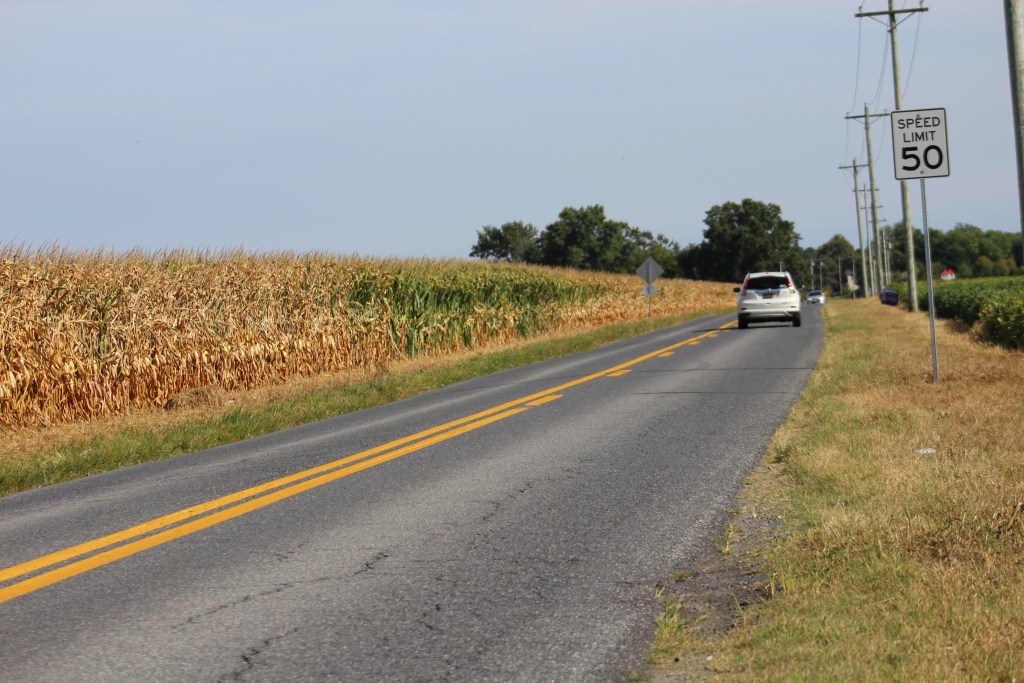 A car drives along a two-lane road in Sussex County outside Lewes. | SPOTLIGHT DELAWARE PHOTO BY OLIVIA MARBLE
A car drives along a two-lane road in Sussex County outside Lewes. | SPOTLIGHT DELAWARE PHOTO BY OLIVIA MARBLEThe working group suggests the county allow housing developers to build denser developments than what would typically be allowed in growth areas if they meet one of two requirements.
The housing developer could either pay a fee that would be used to preserve land elsewhere in the county or make 10% of the housing units affordable for people making 120% of the average median income of Sussex County.
For housing to be considered affordable, it cannot cost more than 30% of a person’s annual income, according to the U.S. Department of Housing and Urban Development.
Currently, the average median income in Sussex County is $97,500, so those housing units would need to be affordable for people making $117,000 – not more than $2,925 a month.
10. Amending the Sussex County Rental Program
Recommendation 10 suggests the county change the Sussex County Rental Program so more housing developers use it.
Currently, in order for a housing development project to qualify for the program, 25% of its units need to have a maximum rent of $765 for a one-bedroom, $915 for a two-bedroom and $1,060 for a three-bedroom.
In return, the county allows those projects to go through an expedited review process and have higher density than what would normally be allowed.
If County Council were to implement Recommendation 10, those rent caps would increase to $1,220 for a one-bedroom, $1,465 for a two-bedroom and $1,695 for a three-bedroom.
The recommendation also suggests the county reduce impact fees and open space requirements for projects in the Sussex County Rental Programs.
11. Creating Transportation Improvement Districts
Transportation Improvement Districts are plans to improve the traffic infrastructure for certain areas by building roundabouts, installing traffic signals, putting up stop signs and more. They can help distribute the costs of these upgrades to private developers in an equitable way, according to DelDOT.
The working group proposes DelDOT and the county work to create improvement districts for all the growth areas and charge a fee for developments in conservation areas to help offset the impacts of added traffic on conservation area roads.
12. Adopting large-scale development ordinance
“Master plan” developments are often larger-scale projects that include residential and commercial properties. This recommendation would add a specific process for these projects to be approved under county codes, which may make it easier for these projects to be constructed.
13. Preserving greenspace
The working group intends to strengthen environmental preservation efforts in the county through this proposal. Developers would have to preserve a minimum of 30% of a forest when developing property inside growth areas and preserve 50% outside growth areas.
If a developer needed to cut down trees in a larger area than that requirement, they would have to plant more trees elsewhere.
14. Encouraging naturalized landscaping
Naturalized landscaping is a type of landscape design that can serve as a habitat for native plants and wildlife. The recommendation suggests the county work with the Sussex Conservation District to support habitat-friendly landscape design, but does not specify how they should work together.
15. Focusing certain subdivision design around conservation priorities
Open space requirements are rules about what percentage of a property a developer can build on. An open space requirement of 35%, for example, would mean that a developer could only build on 65% of the property and would have to leave the rest unbuilt.
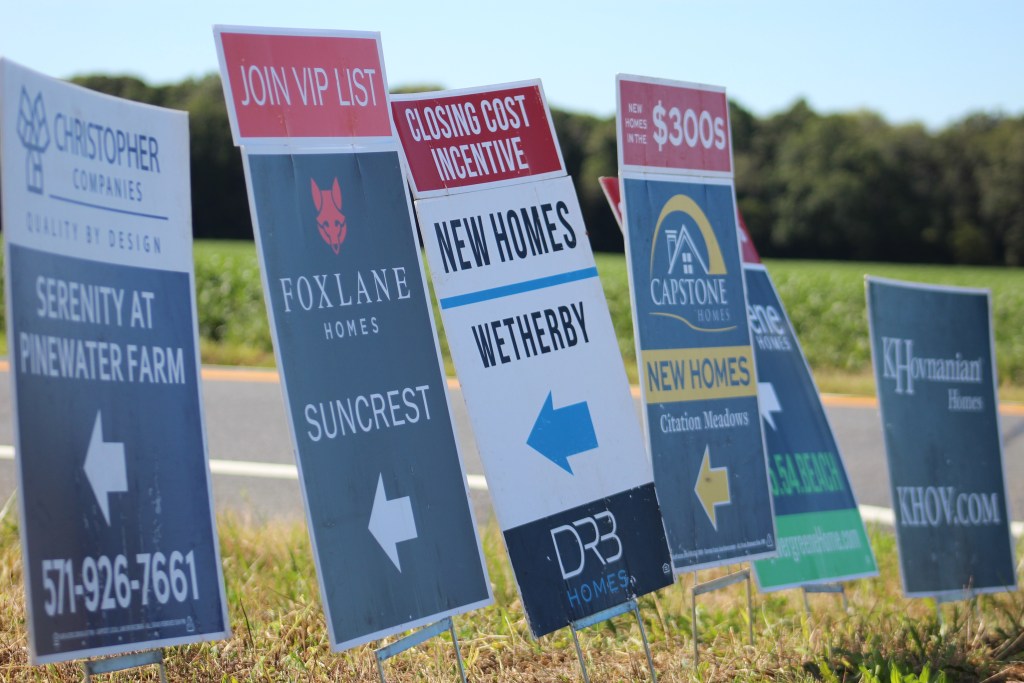 A slew of advertisements for new-build homes and subdivisions, pictured here outside Lewes, are a common sight across Sussex County. | SPOTLIGHT DELAWARE PHOTO BY OLIVIA MARBLE
A slew of advertisements for new-build homes and subdivisions, pictured here outside Lewes, are a common sight across Sussex County. | SPOTLIGHT DELAWARE PHOTO BY OLIVIA MARBLEThis recommendation proposes increasing open space requirements in conservation areas to either 35% or 50% of a property. After some debate among working group members, the proposal leaves the ultimate percentage up to County Council’s discretion.
It also suggests the county require developers to map out the natural resources on their properties to make sure they are protecting them as much as possible.
16. Supporting working farms
With this proposal, the working group advises the county to allow certain commercial uses, like processing facilities or equipment repair, onto farmland so farmers can earn extra income.
17. Exploring a transfer of development rights program
In a transfer of development rights program, developers can build on farmland in areas targeted for growth only if they also purchase the development rights of a farm in an area slated for preservation without building anything on it.
This approach allows farmers in preservation areas to make a profit from developers while also preventing any future housing development on that land. The program is seen as a potential compromise to the debate of whether to restrict housing density on farmland.
The working group asked the county to consider adding this program, but stopped short of recommending it because it could be complicated to implement.
18. Improving subdivision code clarity, consistency
Recommendation 18 proposes the county make criteria used to determine whether a development plan should be approved objective and measurable so there is not any guesswork for the developer or residents on what’s allowed and what’s not.
Builder and working group member Jon Horner said at a recent meeting that vagueness in land use laws lead to a long, drawn-out fight between developers and those who don’t want the development.
“It’s going to lead to exactly what got everybody in this room,” Horner said then.
19. Prioritizing projects advancing county land use goals
The working group’s final recommendation suggests the county create a process that puts projects that have higher housing diversity and better coordination with nearby infrastructure higher in the queue for public hearings so they can be built quicker than others.
Next steps
Working Group members met for a final time at 10 a.m. on Thursday, Sept. 11, to vote on the merits of each recommendation before sending them all to County Council for approval.
Members used a 5-point scale to show how much they agree or disagree with each recommendation, group facilitator Andrew Bing said.
Sussex County Council will be able to see how the group voted on each recommendation, as well as on the recommendations as a whole, he said.
County Council has not yet scheduled a meeting to review the recommendations.

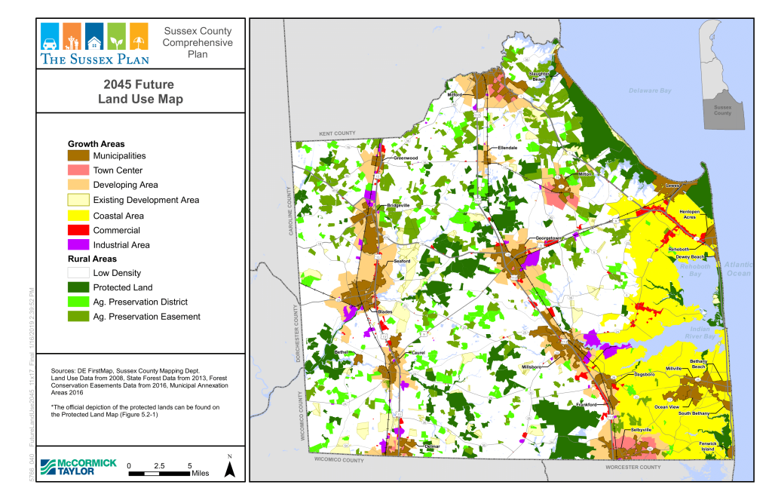
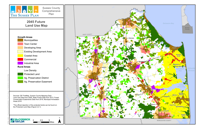

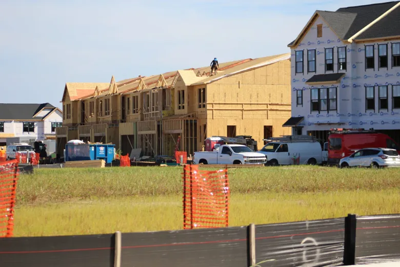
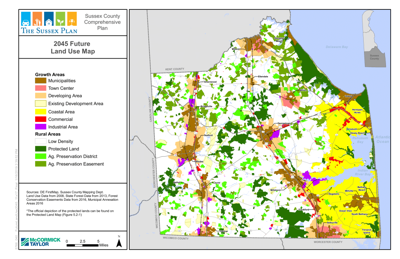








(0) comments
Welcome to the discussion.
Log In
Keep it Clean. Please avoid obscene, vulgar, lewd, racist or sexually-oriented language.
PLEASE TURN OFF YOUR CAPS LOCK.
Don't Threaten. Threats of harming another person will not be tolerated.
Be Truthful. Don't knowingly lie about anyone or anything.
Be Nice. No racism, sexism or any sort of -ism that is degrading to another person.
Be Proactive. Use the 'Report' link on each comment to let us know of abusive posts.
Share with Us. We'd love to hear eyewitness accounts, the history behind an article.